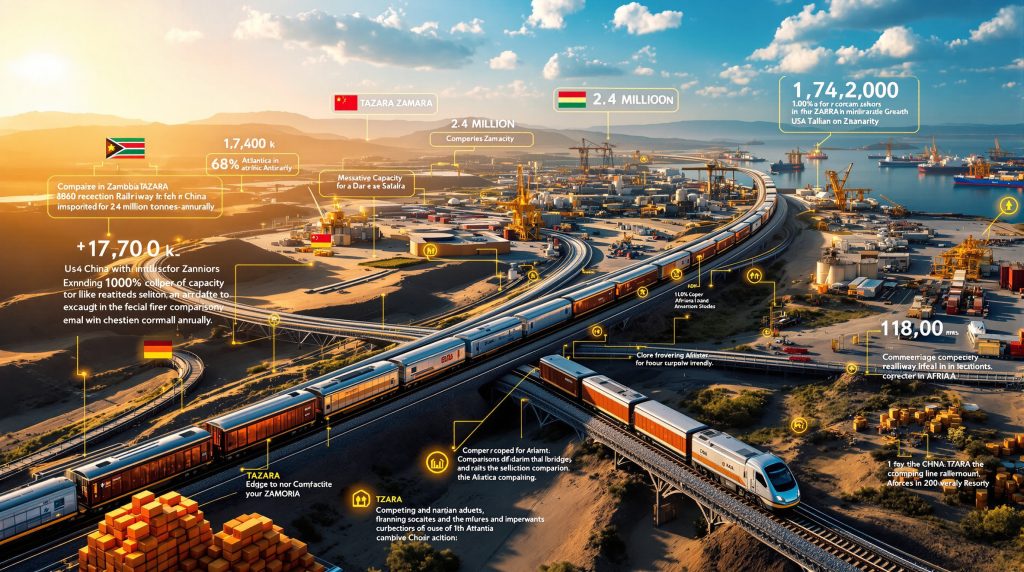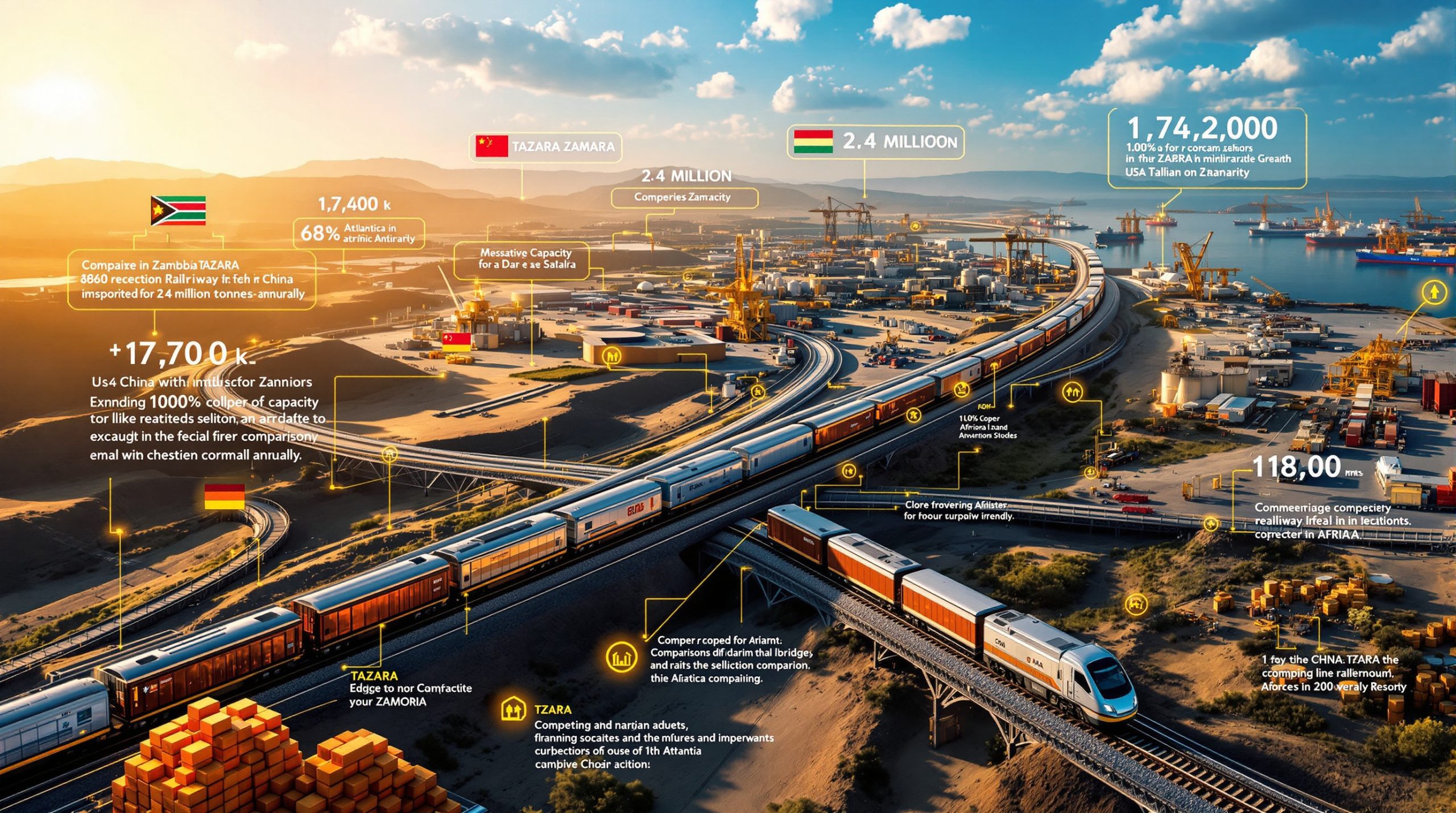China Signs Agreement to Revamp TAZARA Railway in Zambia: Transforming Regional Trade Dynamics
The landscape of African economic development increasingly reflects a complex interplay of infrastructure investment strategies, debt management frameworks, and geopolitical positioning. As continental economies navigate post-pandemic recovery and structural transformation challenges, furthermore, China signs agreement to revamp TAZARA railway in Zambia represents a pivotal moment in reshaping trade corridors and economic relationships across southern Africa. This dynamic environment creates multiple scenarios for regional integration, industrial development, and international partnership models that could fundamentally alter regional commerce patterns.
Understanding these infrastructure-led transformation patterns requires examining how large-scale transport projects influence commodity export routes, manufacturing capabilities, and regional economic integration. The intersection of debt sustainability concerns with strategic infrastructure investment presents unique opportunities for emerging market economies to leverage external partnerships whilst maintaining policy autonomy and economic diversification objectives.
Strategic Railway Modernisation as Regional Economic Catalyst
The recent trilateral infrastructure agreement between China, Zambia, and Tanzania demonstrates how strategic railway investments can fundamentally alter regional trade dynamics. This $1.4 billion modernisation initiative targets the complete rehabilitation of a 1,860-kilometre transport corridor, representing one of the most significant infrastructure commitments in southern Africa in recent years.
The scope of this modernisation encompasses comprehensive infrastructure overhaul including station rehabilitation, track upgrading, tunnel enhancement, and bridge reconstruction across the entire route. Current freight capacity of 100,000 tonnes annually is projected to expand to 2.4 million tonnes, representing a 24-fold increase in throughput capability that could transform regional commodity export patterns and align with South Africa economic opportunities across the continent.
This capacity expansion timeline coincides with Zambia's emergence from a $13.4 billion debt restructuring process, positioning infrastructure investment as both economic development catalyst and strategic relationship management tool. The timing suggests coordinated approach between debt sustainability initiatives and infrastructure development priorities, consequently creating opportunities for enhanced regional integration through improved connectivity.
Infrastructure Investment and Debt Management Integration
Zambia's debt portfolio presents a complex case study in African sovereign debt dynamics. With total obligations of $13.4 billion, the country recently achieved more sustainable repayment arrangements following extensive creditor negotiations. China represents the largest official creditor position at $5.7 billion, accounting for approximately 42.5% of outstanding obligations.
The railway modernisation agreement demonstrates how infrastructure investment can function as both economic development catalyst and creditor relationship management mechanism. Rather than traditional debt forgiveness models, this approach creates tangible asset value whilst maintaining ongoing financial partnerships between creditor and debtor nations.
Historical Chinese investment patterns in Zambia reveal sustained commitment to the metals sector, with approximately $6 billion invested over two decades according to American Enterprise Institute tracking. The concentration of investment in extractive industries suggests strategic focus on commodity supply chain integration rather than diversified economic development, however, the current railway project signals a broader approach to regional economic transformation.
Comparative Analysis of African Trade Corridor Competition
The modernisation directly challenges alternative trade route development across southern Africa. The United States and European Union have backed competing corridor initiatives, including the Lobito Corridor connecting Angola through Zambia to the Democratic Republic of Congo. This creates strategic competition between Atlantic-facing and Indian Ocean-facing export routes for regional commodity flows, furthermore intensifying the geopolitical aspects of infrastructure development across the continent.
Trade Route Capacity Comparison:
- TAZARA Modernised Route: 2.4 million tonnes projected annual capacity
- Current TAZARA Utilisation: 100,000 tonnes annual throughput
- Capacity Utilisation Gap: 96% of projected capacity remains undeveloped
- Strategic Positioning: Indian Ocean access via Dar es Salaam port
The 24-fold capacity increase suggests ambitious projections for regional trade volume growth, requiring substantial increases in commodity production and export demand to achieve utilisation targets. This scale of expansion indicates expectations for regional economic transformation extending beyond current production levels, particularly given the ongoing mining industry evolution shaping global supply chains.
Industrial Development Zone Strategy Along Transport Corridors
The infrastructure agreement incorporates industrial development objectives alongside transport capacity enhancement. Plans include promotion of existing industrial parks and zones along the railway alignment, suggesting comprehensive value-addition strategy rather than simple commodity transport facilitation.
This approach mirrors successful corridor development models where transport infrastructure catalyses broader economic activity including:
- Processing facility development near transport nodes
- Manufacturing cluster creation leveraging improved connectivity
- Service sector expansion supporting logistics and maintenance requirements
- Employment generation across multiple economic sectors
The integration of industrial development with transport infrastructure represents evolution from traditional commodity export models toward value-added production and processing within regional economies. Consequently, this approach could address some of the concerns arising from the DRC cobalt export ban by diversifying processing capabilities across the region.
Copper Export Route Optimisation and Regional Integration
Zambia's position as Africa's second-largest copper producer creates significant strategic implications for export route modernisation. Current copper export patterns rely heavily on southern African port access through South Africa and alternative regional routes. The enhanced TAZARA capacity could fundamentally alter these logistics patterns, particularly as global copper price insights suggest sustained demand growth.
Projected Export Route Scenarios:
Scenario 1: TAZARA Route Dominance
- 60-70% of Zambian copper exports route through Dar es Salaam
- Reduced dependence on South African port infrastructure
- Enhanced integration with Asian supply chains
- Competitive pressure on alternative corridor pricing
Scenario 2: Multi-Route Diversification
- 40-50% TAZARA market share alongside existing routes
- Risk mitigation through transport redundancy
- Balanced logistics cost optimisation
- Maintained relationships with multiple corridor partners
Scenario 3: Regional Hub Development
- Zambia emerges as central African logistics centre
- Transit trade facilitation for Democratic Republic of Congo
- Value-added processing before export
- Industrial cluster development along transport nodes
Zero-Tariff Policy Implications for African Manufacturing
The accompanying commitment to zero-tariff treatment for African exports to China represents significant trade policy enhancement. This preferential access framework creates opportunities for manufacturing competitiveness enhancement and regional value chain integration.
Manufacturing Competitiveness Enhancement:
- Reduced input costs for African manufacturers accessing Chinese markets
- Improved price competitiveness versus other export destinations
- Incentives for local value-addition before export
- Supply chain localisation opportunities
Regional Value Chain Integration:
- Encouragement of production and processing within Africa
- Reduced dependence on imported intermediate goods
- Development of regional manufacturing capabilities
- Technology transfer potential through industrial partnerships
The policy combination of enhanced transport infrastructure and preferential market access suggests coordinated strategy for African industrial development rather than simple commodity extraction facilitation. However, global trade dynamics, including tariffs impact markets, may influence the effectiveness of these preferential arrangements.
Geopolitical Implications and Strategic Competition
The infrastructure modernisation occurs within broader context of great power competition for African partnerships. The project serves multiple strategic objectives beyond economic development, furthermore demonstrating China's commitment to long-term engagement with African economies.
Economic Integration Deepening:
- Enhanced embedding of Zambian and Tanzanian economies within Chinese trade networks
- Supply chain integration with Asian manufacturing centres
- Technology transfer through infrastructure partnership
- Long-term commodity supply arrangement facilitation
Political Influence Enhancement:
- Increased Chinese soft power through visible infrastructure improvements
- Demonstration of successful Belt and Road Initiative implementation
- Model development for other African partnership arrangements
- Counterbalancing of Western influence initiatives
The timing of this commitment, coinciding with Chinese Premier Li Qiang's first visit to Zambia in 28 years, underscores the geopolitical significance of the infrastructure partnership. This high-level diplomatic engagement suggests strategic priority for Chinese leadership in African relationship development.
Regional Economic Transformation Projections
The successful implementation of enhanced railway capacity could catalyse broader regional economic transformation extending beyond immediate transport improvements. China signs agreement to revamp TAZARA railway in Zambia creates multiple development pathways with varying probabilities of success.
2025-2030 Development Scenarios:
Optimistic Transformation Path:
- TAZARA captures majority market share of Zambian mineral exports
- Industrial development zones achieve full capacity utilisation
- Regional economic integration accelerates through improved connectivity
- Technology transfer facilitates manufacturing capability development
Moderate Development Path:
- Balanced competition between TAZARA and alternative corridors
- Steady industrial development along enhanced transport route
- Diversified export strategy reduces single-route dependence
- Gradual manufacturing sector development
Constrained Development Path:
- Operational challenges limit freight volume growth
- Political or economic changes affect partnership stability
- Competition from alternative corridors limits market penetration
- Infrastructure utilisation falls short of capacity projections
Investment Opportunities and Economic Multiplier Effects
The railway modernisation creates multiple investment vectors across regional economies, extending opportunities beyond direct infrastructure construction. In addition, these opportunities extend beyond Chinese companies to include regional and international investors seeking exposure to African infrastructure development themes.
Direct Infrastructure Investment:
- Construction and engineering service opportunities
- Equipment supply and maintenance contracts
- Technical expertise and knowledge transfer
- Project management and logistics support
Supporting Economic Development:
- Freight forwarding and logistics service expansion
- Warehousing and distribution facility development
- Industrial real estate development near transport nodes
- Manufacturing facility establishment leveraging connectivity improvements
Regional Integration Benefits:
- Cross-border trade facilitation services
- Financial services supporting increased trade volumes
- Tourism and service sector development along transport corridor
- Educational and training programme development for technical skills
These opportunities present significant potential returns for investors willing to engage with emerging African markets, particularly given the scale of infrastructure investment and projected economic transformation.
Future Scenarios and Strategic Implications for Continental Development
The TAZARA modernisation establishes potential precedent for infrastructure-led development strategies across Africa. Success metrics will likely influence similar partnership arrangements between China and other African nations, whilst effectiveness of the model may determine broader Belt and Road Initiative expansion patterns.
Critical Success Factors:
- Operational Efficiency: Achievement of projected freight capacity utilisation rates
- Industrial Development: Successful establishment of value-added processing capabilities
- Regional Integration: Enhanced cross-border trade facilitation and economic cooperation
- Debt Sustainability: Demonstration of infrastructure investment compatibility with fiscal management
Broader Continental Implications:
- Policy Framework Development: Potential model for other debt-infrastructure integration arrangements
- Regional Competition Dynamics: Influence on alternative corridor development and utilisation
- International Partnership Evolution: Template for South-South cooperation in infrastructure development
- Economic Diversification Acceleration: Demonstration of manufacturing sector development potential
The project's outcome will provide valuable insights into how strategic infrastructure investment can reshape economic geography and trade relationships in emerging markets. For instance, the successful implementation could serve as a template for other African nations seeking to balance infrastructure development with debt sustainability concerns.
Long-term Regional Transformation Potential
China signs agreement to revamp TAZARA railway in Zambia represents more than isolated infrastructure project; it embodies comprehensive approach to economic transformation that could reshape southern African trade patterns. The integration of transport capacity enhancement with industrial development objectives creates potential for sustained economic growth extending well beyond the project's completion timeline.
The success of this initiative may determine whether similar comprehensive infrastructure partnerships become standard practice across Africa or whether alternative development models gain prominence. Consequently, regional governments, international investors, and development organisations are closely monitoring implementation progress and early results.
The modernisation's impact on regional economic integration, manufacturing development, and trade route competition will provide crucial data points for future infrastructure investment decisions across the continent. Furthermore, the project's approach to balancing Chinese investment objectives with African development priorities offers insights into evolving South-South cooperation models.
This analysis is based on publicly available information and represents general market commentary. Readers should conduct independent research and seek professional advice before making investment or policy decisions. Economic projections and development scenarios involve significant uncertainty and actual outcomes may differ materially from projections discussed.
Looking to Capitalise on African Mining and Infrastructure Developments?
Discovery Alert's proprietary Discovery IQ model delivers instant notifications on significant ASX mineral discoveries, empowering investors to identify actionable opportunities in emerging markets and resource sectors ahead of broader market awareness. With major infrastructure projects like the TAZARA railway transformation creating new opportunities across African mining regions, explore Discovery Alert's discoveries page to understand how historic mineral discoveries have generated exceptional returns, then begin your 30-day free trial today to position yourself strategically for the next wave of mining sector developments.




